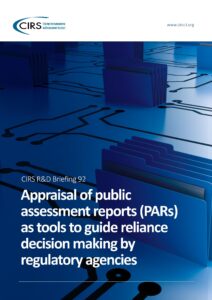Regulatory reliance facilitates regulatory approvals, allows the use of resources more efficiently, and ultimately serves patients by accelerating access to quality-assured, safe, and effective medicines. The World Health Organisation (WHO) recommends that national regulatory agencies should use public assessment reports (PARs) as the primary sources of information for risk-based assessments. However, relying agencies are often challenged by the redacted nature of PARs regarding safety, quality or efficacy.
CIRS undertook a study to assess whether the information needed for reliance is included in PARs of reference agencies. Six new active substances (NASs) from seven reference agencies were assessed, namely, the US Food and Drug Administration (FDA), European Medicines Agency (EMA), Health Canada, Swissmedic, Therapeutic Goods Administration (TGA), Brazilian Health Regulatory Agency (ANVISA), and Medicines and Healthcare products Regulatory Agency (MHRA). Since each agency has different reliance requirements, CIRS consolidated a generic, non-agency-specific list of information that could be of value to undertaking risk-based reviews. This list was used to assess the inclusion of reliance-relevant information within the PARs.
Based on the 33 PARs assessed in this study, it was found that publicly available reference agency documentation contains the majority of the information that relying agencies may require for risk-based reviews. However, none of the agency PARs contained all the identified reliance-relevant information. The Clinical, Benefit-Risk Assessment and Regulatory Background sections of the PARs often contained the greatest amount of reliance-relevant information. In contrast, the Chemistry, Manufacturing and Controls (CMC) and Non-Clinical sections had the least amount of reliance-relevant information.
A comparison of the agencies revealed that PARs developed by EMA and FDA contained more detailed reliance-relevant information than those PARs developed by TGA, ANVISA, Health Canada and Swissmedic. However, it should be noted that a relatively small cohort of PARs was identified for assessment.
In conclusion, no single PAR contained all the reliance-relevant information based on the generic list utilised in this study. However, the PARs contained helpful information that can be used to inform regulatory decisions and their usability for reliance purposes will depend on the relying agencies’ guidelines and requirements. Finally, it should be noted that in addition to PARs, other documents are important to support reliance decision making, such as the marketing authorisation application (MAA) dossier provided by the applicant, the Certificate of Pharmaceutical Product (CPP), and/or the nonpublic assessment report from the reference agency. The relying agency can refer to such additional documentation for any clarifications, to understand further the information that the reference agency considered, and to understand the reference agency’s decision-making process.
Recommendations for the future should focus on:
- ensuring clear communication between agencies and companies during a reliance review
- raising awareness of the importance of PARs for implementing reliance
- improving the availability, completeness and usability of PARs
- advocating for a harmonised standard PAR template or comparable relevant elements within a PAR, which can be used by current and emerging reference agencies.

